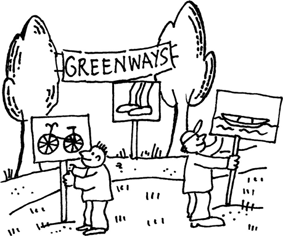Menu
Production
GWs Methodology
Basic elements of a Greenway
1. Marking out the backbone trail
The main backbone trail links together landscape, natural, cultural and historical attractions. The trail should be served by small infrastructure – rest places, visually consistent information posters with maps and trail logo. Cycle trails should have hardened surfaces with low car traffic. Model greenway trails, which meet western European standards, are built as customized trails which are safe and separate users from car traffic.

2. Signposting a variety of local thematic loops and trails
Local trails and loops are linked to the main backbone trail of the Greenway. These are cycle, walking, horse-riding, water, cross-country skiing, horse-carriage paths and trails. They support recreation, interpretation of cultural and natural heritage and environmental education.
3. Tourism product consistent with sustainable tourism principles
Greenways are available as specialized tourism products both to individual tourists and to organized groups. An important part of any greenway product are tourist-related publications – maps and guides.
4. Partnerships in the region and Greenway coordination
Every Greenway is designed and implemented by a group of partners, comprising non-governmental organizations, local government and business. Partners sign a cooperation agreement, choose the main Greenway coordinator and also local coordinators (in the case of long distance trails).
5. Community initiatives aimed at natural and cultural heritage conservation
A Greenway provides a framework for community-based social projects, undertaken by passionate and creative people – leaders of local non-governmental organization, animators of local culture, artists, folk artists, children and youth, teachers, business people etc.
Stages in creating a Greenway

Stage 1: 'organisation'
- formulating an idea for the trail (theme, central idea, geographical scope);
- securing partners from 3 sectors: civil society, public and business;
- preparation and signing of a cooperation agreement comprising a joint vision of the project (see example declaration in box);
- selection of Greenway coordinator and local coordinators (coordinators responsible for specific fragment of long distance trails);
- selection of name and design of logo;
- preparation of concept of trail route;
- preparation of a tourist audit in consultation with partners (e.g. inventory of natural and cultural sites, cultural and artistic events, tourism industry, local heritage products and community-based social initiatives).
Stage 2: 'visualisation'
- preparation of technical project for signposting the trail;
- engaging partners from local government, including large cities along the trail;
- securing funding for visualization of the trail;
- marking out the main backbone trail and thematic local loops (signposting and information signs should contain the greenway’s logo).
Stage 3: Promoting and selling a tourist product
- developing ideas for a marketable tourist product and identifying market opportunities;
- securing partners from the tourism industry and developing a tourist product and selling it;
- preparing information and promotional publications and distributing them (maps, guides, information leaflets, web pages) – at the start, the most important is the trail MAP and WEB PAGE (!).
Stage 4: Supporting local initiatives
- securing funding for local community-based projects related to natural and cultural heritage protection – A GREENWAY NEEDS TO BE FILLED WITH COMMUNITY-BASED INITIATIVES, which involve local residents (this is one of its main differentiating features). The most popular local initiatives on greenways include: cultural and artistic events, galleries and shops selling heritage products, workshops with local artisans and artists, ecomuseums, school nature gardens and environmental education centres.
Stage 5: Creating Greenway infrastructure
- building small infrastructure around trails – resting places, signage, information points;
- engaging those offering accommodation and food directly in the trail initiative; encouraging those in the tourist industry to strive for environmental certification and to increase the quality and scope of their services;
- ULTIMATELY: secure financial resources for staged construction of trails, which separate users from car traffic, and which can run along the backbone trail. The first priority should be trail segments leading into and out of large urban areas.
Network of GWs in Belarus






